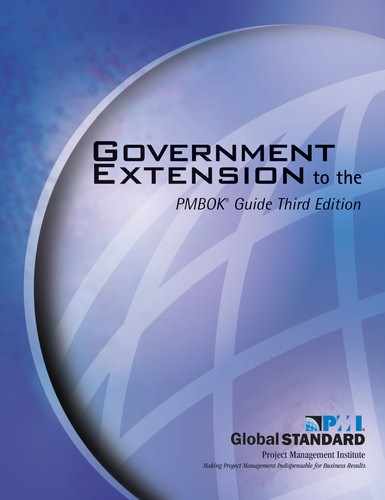Chapter 4
Project Integration Management
According to the PMBOK® Guide—Third Edition, Project Integration Management includes “the processes and activities needed to identify, define, combine, unify, and coordinate the various processes and project management activities within the Project Management Process Groups.” Chapter 4 of the PMBOK® Guide—Third Edition describes seven major integrative project management processes:
- 4.1 Develop Project Charter
- 4.2 Develop Preliminary Project Scope Statement
- 4.3 Develop Project Management Plan
- 4.4 Direct and Manage Project Execution
- 4.5 Monitor and Control Project Work
- 4.6 Integrated Change Control
- 4.7 Close Project.
In many instances, government projects—and the priority accorded to them—result from public policy requirements, which stipulate that project managers ensure there is clear and continuing integration between these policy requirements, the program, and the project’s scope and deliverables. Changes in policy might affect the program and, in turn, cause the project to be modified or even terminated.
4.1 Develop Project Charter
See Section 4.1 of the PMBOK® Guide—Third Edition.
4.1.1 Develop Project Charter: Inputs
See Section 4.1.1 of the PMBOK® Guide—Third Edition.
Government projects may be initiated in order to achieve a specific policy goal of the administration, for example, a reduction in budget deficit, or to achieve an essentially political goal, such as the nationalization or privatization of a utility company. However, the more common reasons to initiate a public sector project are:
- Public health needs (such as mass immunization, hospitals, sanitation, water purification, research, and food and pharmaceutical administration)
- Public safety needs (such as defense, counterterrorism, police and fire protection, disaster prevention and mitigation, crime prevention, land mine eradication, and drug trafficking control)

- Welfare, socioeconomic, and environmental needs (such as community development, poverty alleviation, education and schools, water supply, transportation and roads, energy, social security, environmental protection, and parks and recreation).
4.1.2 Develop Project Charter: Tools and Techniques
See Section 4.1.2 of the PMBOK® Guide—Third Edition.
4.1.3 Develop Project Charter: Outputs
See Section 4.1.3 of the PMBOK® Guide—Third Edition.
4.2 Develop Preliminary Project Scope Statement
See Section 4.2 of the PMBOK® Guide—Third Edition.
4.3 Develop Project Management Plan
See Section 4.3 of the PMBOK® Guide—Third Edition.
4.4 Direct and Manage Project Execution
See Section 4.4 of the PMBOK® Guide—Third Edition.
4.5 Monitor and Control Project Work
See Section 4.5 of the PMBOK® Guide—Third Edition.
4.6 Integrated Change Control
See Section 4.6 of the PMBOK® Guide—Third Edition.
4.7 Close Project
See Section 4.7 of the PMBOK® Guide—Third Edition.
4.7.1 Close Project: Inputs
See Section 4.7.1 of the PMBOK® Guide—Third Edition.
4.7.2 Close Project: Tools and Techniques
See Section 4.7.2 of the PMBOK® Guide—Third Edition.
4.7.3 Close Project: Outputs
See Section 4.7.3 of the PMBOK® Guide—Third Edition.
Sections 4.7.3.1 through 4.7.3.3 of the PMBOK® Guide—Third Edition discuss outputs from the Close Project process. An additional output specific to government projects is described below:
- .4 Organizational Process Assets. See also section 4.7.3.4 of the PMBOK® Guide—Third Edition.
- Project Files. In government projects, the keeping of government records, including project files, is often required by a myriad of laws, regulations, and policies. The objective of these laws, regulations, and policies is to assure that project files may be accessed many years after completion of the project and understood by those unfamiliar with the project. The project files are maintained for the number of years prescribed by the laws, regulations, and policies applicable to the government body.
